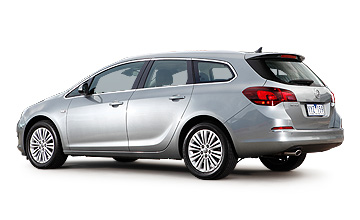BY RON HAMMERTON | 1st Aug 2012

It is also probably the most contemporary of the new Opel models, with up-to-date styling in its three body styles – five-door hatch, three-coupe GTC coupe and Sports Tourer wagon – and an all-turbo range of four-cylinder engines with a reasonable blend of power and fuel economy.
The spunky GTC will get the glory, the five-door hatch will achieve the sales volume, but it is the Sports Tourer in its CDTi diesel guise that should get the plaudits.
This 2.0-litre turbo-diesel wagon was the last of about seven Opel models we sampled at the media launch in the Hunter Valley of New South Wales, but the one that left the greatest impression.
We did not expect much from this rather plain-looking small family hauler after feeling a little deflated by some other cars in the new Opel range, particularly the Corsa light hatch.
But it only took about 100 metres behind the wheel to realise that Opel could be onto something with its Astra diesel models, especially when crossed with the convenience and spaciousness of the Sports Tourer.
The diesel engine, with a handy 350Nm of torque, pulls solidly, even capable of lighting up the front tyres and tugging at the steering wheel in express acceleration.
Equipped with the optional six-speed automatic transmission, this engine can propel the Astra to 100km/h in 9.2 seconds – just 0.2 seconds slower than the sportiest of the two turbo-petrol engines, the 1.6T, in auto guise.
But it is the generous, loping and efficient method of dealing with the daily grind that should appeal to Middle Australia.
Reasonably quiet and easy on the juice, this CDTi Astra requires little effort from the right foot to get the job done in the urban commute or long-distance highway run, which is why European buyers flock to them.
Unfortunately, the diesel engine commands a $4000 premium over the base 1.4-litre petrol engine and $3000 over the 1.6, and even with a thrifty 4.7 litres per 100km fuel economy rating (we only saw about 6.5L/100km in our drive), it would take a long time to recoup the difference.
Still, prospective buyers should try one at the dealership and feel the difference.
Certainly, the 1.4-litre turbo-petrol base model is nothing to write home about, delivering the same sort of performance as the closely related Holden Cruze equipped with the same engine from the General Motors parts bin.
It might be a little quieter when wrapped in Opel’s package, but we are talking middling performance and refinement here. Rivals such as Volkswagen won’t be panicking just yet.
The 1.6-litre turbo Astra Sport variant is better, its extra 29kW shoving the Astra along with reasonable pace.
Like many of the Opel models we drove at the launch, the Astra suffers from a lack of suspension compliance over small road irregularities, but hangs on well when the going gets fraught.
The Astra hatch and Sports Tourer both miss out on the Astra GTC’s HyPerStrut front end – a great way of dealing with the dreaded torque steer of front-drive cars – but in the absence of huge engine performance, this is not a particularly big issue.
Inside, the various Astras we drove were decked out in a variety of trim levels, including high-end optional leather sports seats, but we did not get to sample the standard seats in the base model.
Those in which we parked our backside were cosy indeed, and it was easy to get comfortable behind the adjustable wheel.
Once there, though, the busy instruments are a drawback – less fuss and more clarity is needed here.
The cabin build quality was not entirely perfect, either, with variations in trim fit, and many different surfaces were applied around the cabin in a busy, scatter-gun approach.
However, the overall effect is modern and reasonably stylish, with a mix of black and charcoal plastics and metallic garnishes.
Rear seat accommodation is spacious for a small car, with excellent rear knee and head room.
The Astra Sport hatch was equipped with the optional $2000 FlexRide chassis control system, providing three drive modes – normal, sport and tour – controlled for some reason by two buttons. Sure, we could tell the difference, but only dedicated car nuts should bother.
The electric-assisted steering is a little vague just off centre, but slices and dices corners in an average modern front-drive hatchback sort of manner, though not quite up there with the Golf and newcomers such as the Honda Civic Hatch.
The boot space is generous, aided by a compact temporary spare wheel. And we like the way the hatch is popped open by prodding the Opel badge. It’s our little secret.
And this all brings us to the Sports Tourer with its grunty diesel engine (at least, in this case) and spacious cargo area.
We loved the one-touch fold-down split rear seats, operated by a pair of buttons within easy reach from the back of the vehicle, so there is no need to open the rear passenger doors to fold the seats.
Also, if you want a perfectly flat cargo area, the rear seat squabs fold up and out of the way to allow the seat backs to lie all the way down.
Doubled with the aforementioned diesel engine and six-speed automatic transmission, this wagon ($31,990 plus on-road costs) makes a compelling case as a family day bus.
Small wagons have mostly been driven off the market by the craze for compact SUVs, which is a shame, as vehicles such as this Astra Sports Tourer generally handle better, use less fuel and cost less.
If the price isn’t a deal-breaker, then give it a whirl.